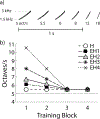Easy-to-hard effects in perceptual learning depend upon the degree to which initial trials are "easy"
- PMID: 31243721
- PMCID: PMC6868315
- DOI: 10.3758/s13423-019-01627-4
Easy-to-hard effects in perceptual learning depend upon the degree to which initial trials are "easy"
Abstract
Starting perceptual training at easy levels before progressing to difficult levels generally produces better learning outcomes than constantly difficult training does. However, little is known about how "easy" these initial levels should be in order to yield easy-to-hard effects. We compared five levels of initial training block difficulty varying from very easy to hard in two auditory-discrimination learning tasks-a frequency modulation rate discrimination (Experiment 1) and a frequency range discrimination (Experiment 2). The degree of difficulty was based on individualized pretraining ~71% correct discrimination thresholds. Both experiments revealed a sweet spot for easy-to-hard effects. Conditions where initial blocks were either too easy or too difficult produced less benefit than did blocks of intermediate difficulty. Results challenge assumptions that sequencing effects in learning are related to attentional spotlighting of task-relevant dimensions. Rather, they support incremental learning models that account for easy-to-hard effects. Further, the results have implications for how perceptual training regimens should be designed to maximize the benefits of rehabilitative perceptual training.
Keywords: Adaptive training; Fading; Progressive training; Transfer along a continuum.
Figures



Similar articles
-
Benefits of fading in perceptual learning are driven by more than dimensional attention.PLoS One. 2017 Jul 19;12(7):e0180959. doi: 10.1371/journal.pone.0180959. eCollection 2017. PLoS One. 2017. PMID: 28723976 Free PMC article. Clinical Trial.
-
Auditory discrimination learning and knowledge transfer in mice depends on task difficulty.Proc Natl Acad Sci U S A. 2010 May 4;107(18):8481-5. doi: 10.1073/pnas.0912357107. Epub 2010 Apr 19. Proc Natl Acad Sci U S A. 2010. PMID: 20404159 Free PMC article.
-
Generalization of non-linguistic auditory perceptual training to syllable discrimination.Restor Neurol Neurosci. 2007;25(3-4):263-72. Restor Neurol Neurosci. 2007. PMID: 17943004
-
Posttraining sleep enhances automaticity in perceptual discrimination.J Cogn Neurosci. 2004 Jan-Feb;16(1):53-64. doi: 10.1162/089892904322755557. J Cogn Neurosci. 2004. PMID: 15006036 Clinical Trial.
-
Auditory perceptual learning and changes in the conceptualization of auditory cortex.Hear Res. 2018 Sep;366:3-16. doi: 10.1016/j.heares.2018.03.011. Epub 2018 Mar 12. Hear Res. 2018. PMID: 29551308 Review.
Cited by
-
Effects of auditory training on low-pass filtered speech perception and listening-related cognitive load.J Acoust Soc Am. 2020 Oct;148(4):EL394. doi: 10.1121/10.0001742. J Acoust Soc Am. 2020. PMID: 33138495 Free PMC article.
-
Cortico-Hippocampal Computational Modeling Using Quantum Neural Networks to Simulate Classical Conditioning Paradigms.Brain Sci. 2020 Jul 7;10(7):431. doi: 10.3390/brainsci10070431. Brain Sci. 2020. PMID: 32645988 Free PMC article.
-
Learning to detect auditory signals in noise: Active top-down selection and stable change in signal representations.J Exp Psychol Hum Percept Perform. 2023 Mar;49(3):428-440. doi: 10.1037/xhp0001082. Epub 2023 Jan 16. J Exp Psychol Hum Percept Perform. 2023. PMID: 36649167 Free PMC article.
-
Familiarization with meaningless sound patterns facilitates learning to detect those patterns among distracters.Front Psychol. 2022 Sep 14;13:957389. doi: 10.3389/fpsyg.2022.957389. eCollection 2022. Front Psychol. 2022. PMID: 36186319 Free PMC article.
References
-
- Ahissar M, & Hochstein S (2004). The reverse hierarchy theory of visual perceptual learning. Trends in Cognitive Sciences, 8(10), 457–464. - PubMed
-
- Amitay S, Irwin A, Hawkey DJ, Cowan JA, & Moore DR (2006). A comparison of adaptive procedures for rapid and reliable threshold assessment and training in naive listeners. The Journal of the Acoustical Society of America, 119(3), 1616–1625. - PubMed
-
- Carvalho PF, & Goldstone RL (2015). The benefits of interleaved and blocked study: Different tasks benefit from different schedules of study. Psychonomic Bulletin & Review, 22(1), 281–288. - PubMed
-
- James WJ (1890). The Principles of Psychology. New York, NY: Dover.
MeSH terms
Grants and funding
LinkOut - more resources
Full Text Sources

